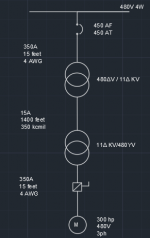electrofelon
Senior Member
- Location
- Cherry Valley NY, Seattle, WA
- Occupation
- Electrician
I don't see any way around having some sort of OCPD in between the transformers. See 450.3, your second transformer needs primary protection and I don't see any allowance to protect it by the first transformer OCPD. Pad mounts typically have bayonet fuses built in that can take care of that.Because by NEC 240.21(C)
Therefore, we always use a delta configuration on the secondary side to avoid adding an 11 KV circuit breaker at the secondary.

